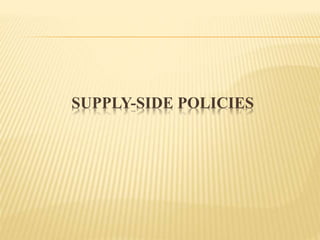
Boost Potential Output Through Supply-Side Policies
- 2. The overreaching goal of supply-side policies is to increase the potential output of the economy by increasing the quantity of the factors of production and/or improving the quality of the factors of production. Supply-side policies can be divided into: Market-oriented supply-side policies Interventionist policies
- 4. These policies focus on allowing markets to operate freely, with minimal government intervention. The word “incentives” is often used to describe these policies, as they are designed to increase the incentives for labour to work harder and more productively, and to increase the incentives for firms to increase productivity
- 5. REDUCTION IN INCOME TAXES If people work harder and make more money, it is possible that they will have to pay higher taxes on the higher levels of income. This may act as a disincentive to work. If taxes are reduced, it is hoped that there will be a greater incentive for labour to work harder and to become more productive, thus increasing the potential output of the economy.
- 6. REDUCTION IN CORPORATION TAXES If businesses are able to keep more of their profits, then they will have more money available for investment. As investment is the addition of capital stock to the economy, this will increase the potential output of the economy. Moreover, if businesses know that they are going to be able to keep a larger share of their profits, rather than give it to the government in taxes, then they will have more incentive to produce efficiently.
- 7. REDUCTION IN TRADE UNION POWER It is often perceived that trade unions push wages up too high and increase the costs of production to firms. As a result, a reduction in trade union power will reduce the ability of unions to negotiate high wages and therefore lower the costs of production to firms, thus increasing their potential output. However, the main goal of trade unions is to protect the rights of workers, and reduced union power may result in the exploitation of workers.
- 8. REDUCTION OR ELIMINATION OF MINIMUM WAGES Minimum wage will keep the price of labour at a level above its free market level. If the minimum wage were to be abolished, then this would also decrease the costs of production and increase aggregate supply. While this might provide some benefit in terms of the overall growth of the economy, it will reduce living standards for those workers who were working for minimum wages
- 9. REDUCTION IN UNEMPLOYMENT BENEFITS If unemployed people are given generous unemployment benefits from the government, it may be argued that they have less incentive to find jobs. These economists would recommend that unemployment benefits be reduced to encourage unemployed people to take the available jobs in the economy.
- 10. DEREGULATION If governments have placed many regulations on the operations of businesses, then this may increase their costs of production, thereby reducing aggregate supply in the economy. A reduction in the number and /or the severity of regulations, i.e. deregulation, will lower their costs and increase aggregate supply. However, this might include reduced regulations on safety or environmental standards, and this can have severe negative consequences for workers and the environment.
- 11. PRIVATIZATION This is the sale of public, government-owned firms, to the private sector. According to market-oriented economists, privately-owned profit-maximizing firms will be much more efficient and productive than government-run firms. They will have the incentive to increase potential output
- 12. INTERVENTIONIST SUPPLY-SIDE POLICIES These policies are based on the idea that the government has a fundamental role to play in actively encouraging growth. They include
- 13. EDUCATION AND TRAINING In order to constantly increase the quality of labour, it is the responsibility of the government to ensure that education and training facilities are geared to providing the necessary skills and knowledge for a dynamic economy This is related to both the skills and knowledge that young people need to help them enter the labour force and also to the retraining of workers to help them adjust to changing economic situations.
- 14. RESEARCH AND DEVELOPMENT (R&D) It is important that an economy’s firms are able to stay up-to-date with modern developments, to develop new production techniques and to constantly seek improved methods of production. All these may increase the economy’s potential output, but will involve extensive spending on R&D. Governments can actively encourage research and development by firms by offering tax incentives. For example, they could allow firms not to pay taxes on the retained profits used for R&D. this is known as tax credit. Governments could also finance R&D in public research facilities and universities.
- 15. PROVISION OF INFRASTRUCTURE The productive potential of an economy will be enhanced by improved infrastructure, such as better transportation linkages and telecommunications.
- 16. IMPROVED INFORMATION Governments can finance trade fairs to facilitate the sharing of expertise and information among a country’s firms.